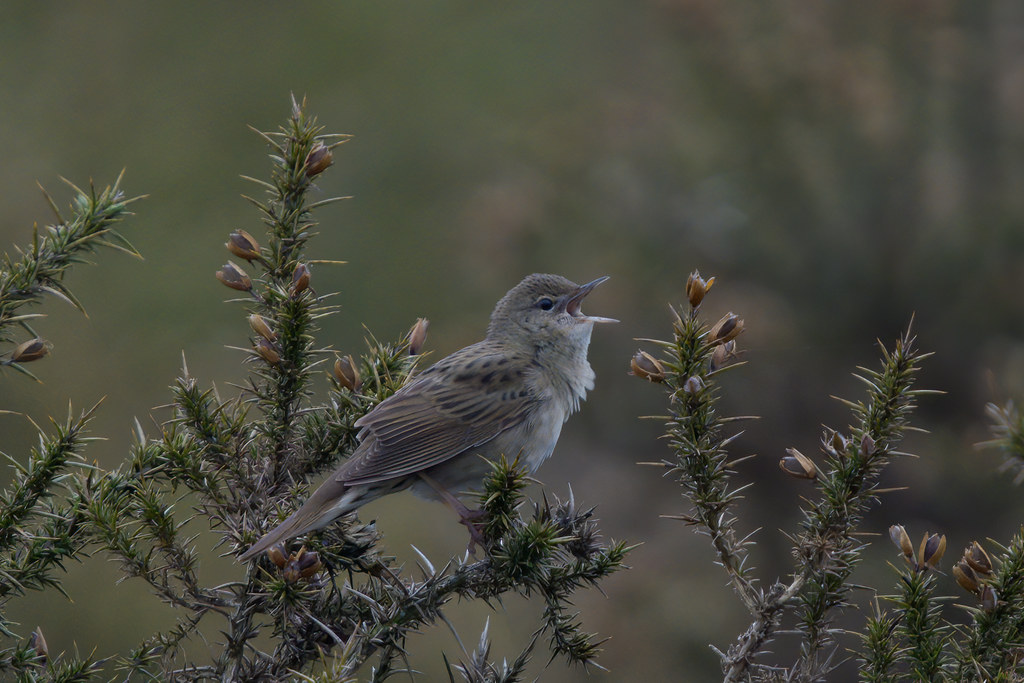
Tim writes: the name warbler was coined by Thomas Pennant in 1773 so what do you think Grasshopper Warbler (Locustella naevia) was called prior to that? Well nearly a hundred years earlier in 1678, John Ray (in the first bird book in the English language) called it “The Titlark that sings like a Grasshopper, Locustella”. Titlark is an old name for a Pipit, and Locustella is the genus to which Grasshopper Warbler belongs and simply means little grasshopper. The specific name naevia means freckled referring to the subtle dark markings in its plumage. Incidentally Thomas Pennant called it rather clumsily “Grasshopper Lark Warbler”. I find it interesting that its song was likened to an insect during the 17th and 18th centuries, but as technology progressed so did the things it was compared with (eg mill wheels, spinning wheels, fishing reels and bicycle wheels)
Grasshopper Warbler is a pretty uncommon and usually rather elusive breeding bird. There are about 13,000 breeding pairs in Britain but compared with eg Reed Warbler that has 130,000 pairs, it is ten times rarer. I’m fortunate to have a breeding site just a couple of miles from my house so I can usually get a glimpse of one if I really try. One early morning there were two males “reeling” and the competition seemed to make them choose high perches to outdo the competitor. I was delighted when this individual perched on top of a gorse bush in full view. During a lifetime of birdwatching I have rarely seen a Grasshopper Warbler unless it was drawing attention to itself by reeling. I have seen maybe a handful of birds on migration, but generally speaking they are extraordinarily elusive.
Mark writes: Tim’s just a stripling so he probably doesn’t have this problem but I know that I struggle to hear Grasshopper Warblers these days. I know this not because I hear fewer of them (because maybe there are fewer of them!) but because I struggle even to hear them on recordings when people with younger ears, or hearing aids, tell me that they can hear them clearly. Try listening to these songs and see whether you can hear the reeling song – I can on the first and third recordings but I really struggle on the second.
[registration_form]
Tim, thanks for your interesting history of bird names. It’s so important to keep tabs on past naturalists — the way they observed and thought.
Mark, ditto re the second recording — I struggled to hear it without my hearing aids.
The Reverend Charles Swainson in The Provincial Names and Folk Lore of British Birds (1885) gives Grasshopper Lark, Cricket Bird (Norfolk) and Brake Hopper for the Grasshoppper Warbler. The last of those as a result of ‘its habit of lurking in thick bushes’.
Best time to hear them is at dusk on a hot, humid, thundery storm evening, when they are much louder.
Can be a bit annoying though when what you’re looking for are nightjar.
I missed my annual fix of trying to hear groppers this year as our local RSPB reserve was closed at the appropriate time. I can hear them now I have NHS digital hearing aids but my unaided husband, who is older than me and much older than you, Mark, is still annoyingly better at picking them up. I would also concur with Tim, there are at least 10x more reed warblers on the reserve.